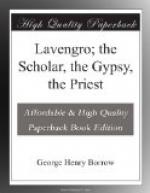Ah, that Irish! How frequently do circumstances, at first sight the most trivial and unimportant, exercise a mighty and permanent influence on our habits and pursuits!—how frequently is a stream turned aside from its natural course by some little rock or knoll, causing it to make an abrupt turn! On a wild road in Ireland I had heard Irish spoken for the first time; and I was seized with a desire to learn Irish, the acquisition of which, in my case, became the stepping-stone to other languages. I had previously learnt Latin, or rather Lilly; but neither Latin nor Lilly made me a philologist. I had frequently heard French and other languages, but had felt little desire to become acquainted with them; and what, it may be asked, was there connected with the Irish calculated to recommend it to my attention?
First of all, and principally, I believe, the strangeness and singularity of its tones; then there was something mysterious and uncommon associated with its use. It was not a school language, to acquire which was considered an imperative duty; no, no; nor was it a drawing-room language, drawled out occasionally, in shreds and patches, by the ladies of generals and other great dignitaries, to the ineffable dismay of poor officers’ wives. Nothing of the kind; but a speech spoken in out-of-the-way desolate places, and in cut-throat kens, where thirty ruffians, at the sight of the king’s minions, would spring up with brandished sticks and an ‘ubbubboo like the blowing up of a powder-magazine.’ Such were the points connected with the Irish, which first awakened in my mind the desire of acquiring it; and by acquiring it I became, as I have already said, enamoured of languages. Having learnt one by choice, I speedily, as the reader will perceive, learnt others, some of which were widely different from Irish.
Ah, that Irish! I am much indebted to it in more ways than one. But I am afraid I have followed the way of the world, which is very much wont to neglect original friends and benefactors. I frequently find myself, at present, turning up my nose at Irish when I hear it in the street; yet I have still a kind of regard for it, the fine old language:
A labhair Padruic n’insefail nan riogh.
One of the most peculiar features of this part of Ireland is the ruined castles, which are so thick and numerous that the face of the country appears studded with them, it being difficult to choose any situation from which one, at least, may not be descried. They are of various ages and styles of architecture, some of great antiquity, like the stately remains which crown the Crag of Cashel; others built by the early English conquerors; others, and probably the greater part, erections of the times of Elizabeth and Cromwell. The whole speaking monuments of the troubled and insecure state of the country, from the most remote periods to a comparatively modern time.




